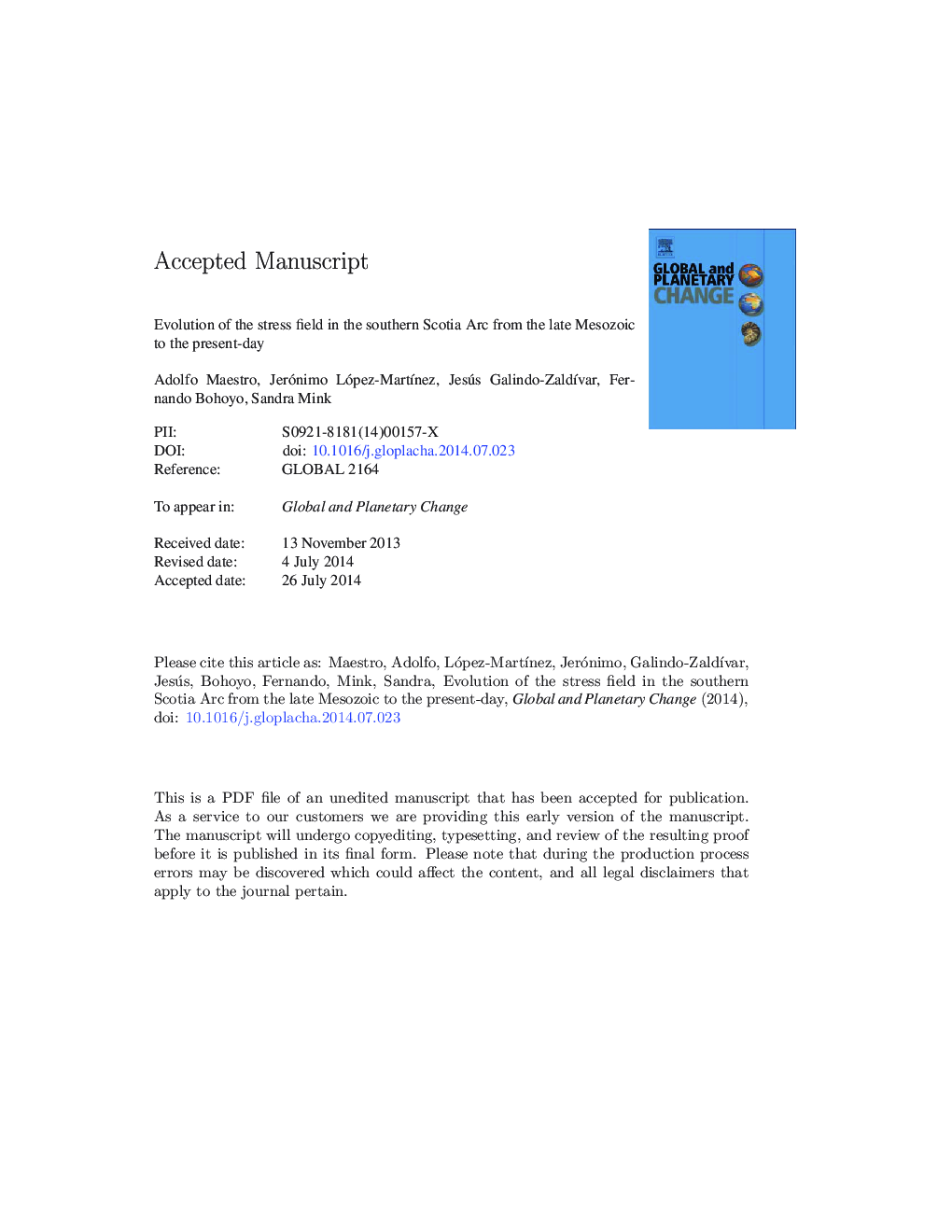| کد مقاله | کد نشریه | سال انتشار | مقاله انگلیسی | نسخه تمام متن |
|---|---|---|---|---|
| 6348159 | 1313641 | 2014 | 77 صفحه PDF | دانلود رایگان |
عنوان انگلیسی مقاله ISI
Evolution of the stress field in the southern Scotia Arc from the late Mesozoic to the present-day
دانلود مقاله + سفارش ترجمه
دانلود مقاله ISI انگلیسی
رایگان برای ایرانیان
موضوعات مرتبط
مهندسی و علوم پایه
علوم زمین و سیارات
فرآیندهای سطح زمین
پیش نمایش صفحه اول مقاله

چکیده انگلیسی
The geological evolution of the Scotia Arc, which developed between Antarctica and South America, has facilitated the connection between the Pacific and Atlantic oceans and, has important global implications. To improve the knowledge of the late Mesozoic evolution of the southern Scotia Arc, over 6000 brittle mesostructures were measured over the last 20Â years at different outcrops from the northern Antarctic Peninsula and the South Shetland Islands as well as the James Ross and South Orkney archipelagos. This dataset covers a length of more than 1000Â km of the arc. Fault data were analysed using the Etchecopar, y-R, Right Dihedra, Stress Inversion and Search Grid Inversion Palaeostress Determination methods. A total of 275 stress tensors were obtained. The results showed that the maximum horizontal stress was in the ENE-WSW and the NW-SE orientations and that the horizontal extension tensors were oriented NE-SW and NW-SE. In addition, seismic activity and focal mechanism solutions were analysed using the Gephart method to establish the present-day stress field and characterise the active tectonics. The results obtained suggest that there is a regional NE-SW compression and a NW-SE extension regime at the present day. The Southern Scotia Arc has a complex geological history due to the different tectonic settings (transform, convergent and divergent) that have affected this sector during its geological evolution from the late Mesozoic until the present day. Six stress fields were obtained from the brittle mesostructure population analysis in the region. The NW-SE and N-S maximum horizontal stresses were related to a combination of Mesozoic oceanic subduction of the former Phoenix Plate under the Pacific margin of the Antarctic Plate, Mesozoic-Cenozoic subduction of the northern Weddell Sea and the Oligocene to the Middle Miocene dextral strike-slip movement between the Scotia and Antarctic plates along the South Scotia Ridge. The NE-SW compression was related to late Miocene to present-day sinistral transcurrent movement along the South Scotia Ridge. Finally, the NW-SE extensional stress field may be related to the development of the following back-arc basins: the Late Cretaceous-Eocene Larsen Basin, the Lower to Middle Miocene Jane Basin and the Pliocene to present-day Bransfield Basin. In addition, the NE-SW and the E-W tensional stress fields were related to the Oligocene opening of the Powell Basin.
ناشر
Database: Elsevier - ScienceDirect (ساینس دایرکت)
Journal: Global and Planetary Change - Volume 123, Part B, December 2014, Pages 269-297
Journal: Global and Planetary Change - Volume 123, Part B, December 2014, Pages 269-297
نویسندگان
Adolfo Maestro, Jerónimo López-MartÃnez, Jesús Galindo-ZaldÃvar, Fernando Bohoyo, Sandra Mink,